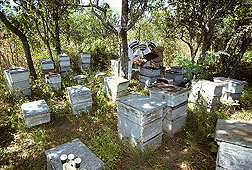Science Update
Using EST Databases for Population Studies
A new technique to obtain genetic markers for sorting out corn rootworm (Diabrotica virgifera) populations is now available to researchers. Scientists often use sections of DNA called “short sequence repeats” (SSRs) to study the interactions between different populations of the same species.
But the SSRs are typically identified by random, expensive, and time-consuming searches through the total DNA extracted from an individual organism. SSRs are also found in sections of DNA called “expressed sequence tags” (ESTs), and species-specific EST databases are already available for a range of plants and animals.
In this study, researchers developed two sets of corn rootworm SSRs. One set contained 17 SSRs developed from the total DNA of corn rootworms. The other set of 17 SSRs was created from sequences in an existing database of 6,397 corn rootworm ESTs.
The researchers found that analyses using both sets gave similar results, including assigning individuals to the correct populations with up to 80 percent accuracy. These results suggest that population geneticists can save time and money by using ESTs in existing databases to identify SSRs instead of developing new SSRs from scratch.
This method is faster and cheaper than existing techniques and can be used to characterize genetic variation in populations of any animal species.
Thomas Sappington, USDA-ARS Corn Insects and Crop Genetics Research Unit, Ames, Iowa; phone (515) 294-9759.
|
|
Ozone Might Help Make Beehives Cleaner and Safer
Ozone might help make hives cleaner and safer for America’s beleaguered honey bees. Studies elsewhere indicate that residues from coumaphos and tau-fluvalinate, two pesticides widely used by beekeepers to control Varroa mites, can accumulate in hives. Researchers placed glass vials of the pesticides in a small, tightly sealed chamber and then exposed the substances to a flow of ozone gas. They found that when they applied 500 parts per million of ozone in a chamber kept at about 93˚F for 10 to 15 hours, low concentrations of both pesticides were degraded. Breaking down higher concentrations of tau-fluvalinate required 20 hours of ozone application.
The scientists were also able to kill larvae and adults of wax moth—a noted honeycomb pest—with just a few hours of ozone exposure, but killing moth eggs required a few days of exposure to the gas.
Ozone also destroyed microbes that cause major bee diseases such as chalkbrood and American foulbrood, but much higher concentrations and longer fumigation times were needed.
Rosalind James, USDA-ARS Pollinating Insect Biology, Management, and Systematics Research Unit, Logan, Utah; phone (435) 797-0530.
Avian Influenza Genome Sequences Released
The complete genetic coding sequences of 150 different avian influenza viruses have been released by USDA scientists and collaborators in government, industry, and universities. The release to GenBank—the National Institutes of Health’s genetic sequence database—was part of a special sequencing project supported by the Presidential initiative on avian influenza.
Partners involved in collecting the viruses included USDA’s Animal and Plant Health Inspection Service’s Wildlife Services, the University of Georgia (UGA), Ohio State University (OSU), the University of Alaska-Fairbanks, and others.
Virus isolates were prepared at the ARS Southeast Poultry Research Laboratory (SEPRL) in Athens, Georgia. Then the viral noninfectious genetic material—ribonucleic acid, or RNA—was sent to industry collaborator SeqWright Corporation in Houston, Texas, which fully sequenced the genome of each virus. The sequence information was reviewed and annotated at SEPRL for release to GenBank.
The sequence information will be combined with studies comparing the viruses’ ability to infect and cause disease in chickens, turkeys, and domestic ducks. The biological characterization was performed with collaborators at UGA, OSU, and University of Delaware.
The sequence analysis and biological data will help researchers learn more about virus biology and how these viruses cause disease in humans and other animals. The information will also support development of diagnostic tests for avian influenza viruses.
David Suarez, Exotic and Emerging Avian Viral Diseases Research Unit, Southeast Poultry Research Laboratory, Athens, Georgia; phone (706) 546-3479.
"Science Update" was published in the February 2009 issue of Agricultural Research magazine.







